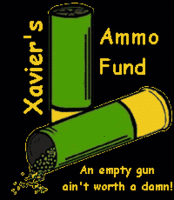Flamecutting
 Often folks ask what "flame cutting" is. Here is what it looks like. Flame cutting is created by hot ignition gases escaping the cylinder gap of a revolver and burning away the top strap. It's primarily seen in .357 magnum and .44 magnum revolvers, but a .38 special firing hot loads can also receive similar damage. In most cases flame cutting is self limiting. Once the closer metal is eroded away, the erosion stops because the gases have room to dissipate.
Often folks ask what "flame cutting" is. Here is what it looks like. Flame cutting is created by hot ignition gases escaping the cylinder gap of a revolver and burning away the top strap. It's primarily seen in .357 magnum and .44 magnum revolvers, but a .38 special firing hot loads can also receive similar damage. In most cases flame cutting is self limiting. Once the closer metal is eroded away, the erosion stops because the gases have room to dissipate.Because flame cutting indicates hot loads being used in addition to a wide cylinder gap, end shake on such a revolver should be checked scrupulously.
Labels: Gun Collecting, Smith and Wesson








11 Comments:
But, how does it affect the value, or utility?
Mr Fixit
Actually, it's not "flame" cutting, it's a sandblasting effect. The hot gasses throw powder and combustion debris at high speeds, which causes the erosion.
Yes, I'm sure the temperature and flame have some effect, but the majority of the damge comes from the mechanical impact.
Doc.
Thanks for the excellent pic Xavier. On a scale of 1-10, how would you rate the severity of the pictured example? I have not seen enough to know serious from insignificant.
Thanks
I know it happens, but, I have yet to see it on a handgun of mine. I have over 1200 MAGNUM rounds in my Blackhawk and have not seen any signs.
I wonder if there is a "magic formula" for determining if your wheelie will see flame cutting?
I'll try to take the questions on one by one....
mr., in general, if a buyer knows what to look for, it does affect value. Flamecutting is indicative of cylinder/forcing cone misalignment, a wide cylinder gap, a loose cylinder, and hot loads. While not structurally significant in and of itself, the problems it indicates can be.
docn, the common name for it around here is flamecutting.
AL, the severity of the pictured example on a scale of 1-10 would be about a 7 or 8. The real damage would be the cylinder end shake and general looseness of the gun.
As long as no more than 10% of the total topstrap cross section is eroded, the structural integrity is not compromised. At least that's the rule of thumb.
So is the little piece of stainless S&W puts there on the 340PD and the 360PD replaceable? I think its stainless???
Xavier: can this type of damage be repaired----at a reasonable cost?
Xav...Many thanks for the terrific pic. I going to check my revolvers right after posting this comment.
May take awhile. :)
Bob, I'm not familiar with the little stainless piece. It's probably replaceable.
anon,anything can be reaired for the right money. Can flamecutting be repaired reasonably? IMHO, no. the source of the problem usually can be though.
No, generally speaking the damage is not repairable.
Doing so would require either careful welding (and the related heat-treatment issues with doing so) or milling a slot or groove and fitting an insert of some sort.
Both are possible, but for the most part not practical.
On the positive side, the damage shown in X's example is extensive- probably the result of several hundred or even several thousand Magnum rounds, and/or the result of a bad cylinder gap or misalignment.
It's not a concern for anyone that only shoots a few boxes a year through that particular gun.
Doc.
Wow, great article, I really appreciate your thought process and having it explained properly, thank you!
Cutting flame
Post a Comment
<< Home